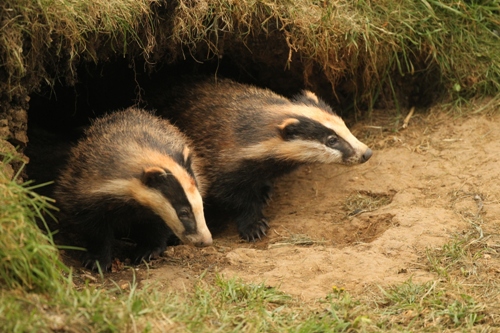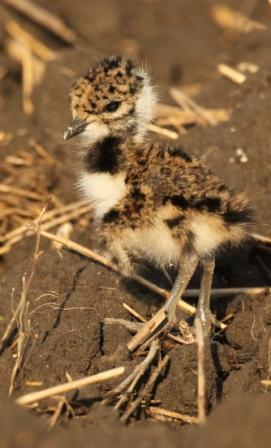I painted this after photographing some fox cubs that had occupied an unused part of a badger sett.
I first noticed the presence of foxes after walking over a
local badger sett checking it for signs of life and spotting a half-gnawed pheasant
leg poking out of one of the holes. I realised a fox must be using part of the
sett for a den. My suspicions were
confirmed when I then saw the remains of rabbits and the wing of a young rook
because this meant that it was very likely a vixen was there with cubs. Urban foxes can be
easy to photograph because they are so habituated to people. I have had great
success watching them in this way, although for me it does feel slightly like
‘cheating’.
But properly wild foxes in the countryside can be very difficult
subjects to study indeed. I have been outwitted by them on several occasions. If a vixen catches the
scent of a human anywhere near her den she might move the cubs, so I knew I had
to be very careful and keep any disturbance to an absolute minimum.
The foxes were living at one end of the badger
sett, which is large and ranges across the top of a daleside and rabbits were
also living in one section. It isn't uncommon for foxes to occupy badger setts, although if you grew up reading Beatrix Potter and read The Tale of Mr Todd, in which Old Brock the badger is known for staying in Mr Todd the fox's home, you'd be forgiven for thinking it was the other way around!
Just 25 yards away is a large, lone sycamore tree. I decided that this would make
an ideal place for a hide. Since I knew my scent
would already be around I decided to act fast and put a hide up that very
afternoon. I made a platform five metres up the tree and put my hide on top of
it.
The height gave me
added advantage, because from there my scent was more likely to disperse.
But although the sett
was clearly occupied with foxes and rabbits there was little sign of badger
activity. I knew there was
another sett just 80 yards lower down the daleside, so I headed off to see if
anything was happening there.
There were plenty of
signs of badger activity in this lower sett. Freshly dug huge spoil heaps marked
out the entrance holes. Resting on top of these heaps were piles of bedding
having a good airing before being dragged back down the holes at a later date. There
were plenty of tracks leading up the dale marking out the badgers’ pathways. And
I was delighted to see that the grass was flattened all around the holes – a
good indicator that there might be several cubs in residence. What luck – two
occupied setts, one containing a fox family the other a badger clan. I might
even be able to see both badger and fox at the same time!
I was even more pleased
when just as I was leaving the heavens opened and it rained hard for over an
hour, washing away any sign that I had been there. Things were looking good.
The next evening I
headed to the new hide. But I got distracted when I spotted four badger cubs emerge
from the sett lower down. They were with two adults and since it was only 8pm and still very light I couldn’t
resist staying there to photograph them first. I watched them as they
the adults groomed the cubs and the cubs played together in the evening light
and an hour passed before I remembered the fox den.
The light was fading by
now and I was worried that I was a little late. I like to be in my hide before
the cubs emerge for the evening. I began to feel a little annoyed with myself
for leaving it so late, when I spotted something flash down the hole as I
approached. I hoped I hadn’t
frightened the vixen off and so I climbed the ladder as quietly as possible and
settled down to wait. But within half an hour a cub tentatively poked his head
up.
It was followed by
another and then a third. It wasn’t long before the three cubs began to romp
around but, frustratingly, it was too dark to take any pictures. Watching the fox cubs
was even more interesting than watching the badger cubs. The fox cubs were so
playful, chasing each other and doing practice pounces even at this young age. The fox cubs played
outside the den until nearly 11pm
but the vixen didn’t appear – it could be by now that she had already left the
den preferring the peace and quiet of living alone again, albeit close by, and
just returning from time to time to check on and feed her increasingly
independent cubs. It was pitch black so I headed home.
Spurred on by having
had such a good sighting I woke at 3am
the next morning and climbed into my hide carrying some three stone of
equipment up the ladder in the black- dark. As it started to get
light I heard a blackbird chink its alarm call and I quickly checked my camera
settings just in case the vixen was on its way. But there was nothing.
About half an hour
later I heard a crow calling. Crows will often mob foxes, so again I got my
cameras ready and waited expectantly for the vixen to appear. But yet again there
was nothing and as the morning wore on this pattern of expectation followed by
disappointment continued. A chaffinch called out
in alarm, but again it led to nothing. Then a great-tit did the same. Then the
crow flew to the ground and began to peck over the scraps of food left by the
foxes.
Watching the crow I
realised that he was very nervous around the holes and rightly so as the vixen and
the crow are arch enemies.I finally gave up around
8am having seen nothing but
this darn crow. After my late night and very early start I had only had three
and a half hours sleep and I felt quite despondent.
But I was determined
not to give up and that evening I went back. But again I got distracted by the
badgers on my way so this time, instead of arriving late and risking disturbing
the fox cubs I went back to my car and watched one of the cubs with my
telescope.
The next night I got
to my hide at 7.45pm . I
could see the badger clan scratching and playing in the valley below and I was
torn between the two, wanting to be in two places at once. But I really wanted to
see the fox cubs so I stuck it out, waiting and hoping that this time I would
be lucky. But they didn’t appear and I went home feeling cheated yet again. I wasn’t able to get
to the hide again for a week as I had a lot to get ready for my summer
exhibition which was due to open that week.
Once the exhibition
was in full swing and the first wave of visitors had gone home I returned to
the den. Again the badgers were
out early, but this time I headed straight for the hide and was rewarded when a
fox cub made an appearance at 9pm .
I was surprised to see how much it had grown in just a week. I hoped that another
would join it, but it walked across to the entrance of another hole and sat
down in front of it and fell asleep for half an hour. Occasionally it lifted
its head up and at one point it snapped
at a crane fly – commonly known as a ‘daddy longlegs’ - that flew too close.
Then it got up,
stretched and began hunting more crane flies, stalking them through the long
grass.
It caught dozens and
ate them all. Some rabbits playing nearby caught its eye and it started to
stalk them. But the adult rabbits soon spotted it and began thumping their back
legs as a warning. The noise unnerved the fox cub which scampered back into its
hole for safety.
It soon remerged though
having learnt its lesson and resumed its insect hunt further down the valley
where I lost sight of it in the darkness. I tried to see this
fox family on several further occasions but I didn’t get to see a fox again.
They are known to move den sites when the cubs get bigger or weather permitting
will choose to live above ground in cornfields or thickets. When I saw a rabbit sat outside the fox
holes my suspicions were confirmed that the foxes had move on.
I switched to watching
the badger cubs in the lower sett, but in spite of some success this time
around I couldn’t help but feeling infuriated to have been outwitted by these
cunning foxes once again.














































